Interview with Lidia Bastianich – Part 1 and a recipe for Rice and Zucchini Crostata (Torta di Riso e Zucchine)
Julia’s inspiration on Lidia’ s television career was evident. “I love to communicate a way of life, a passion, a message. It is what Julia did so well. It was never about her. Some chefs that are on television, it is all about them. That is why Julia was so great. She was interested in the viewers and getting something going in the kitchen. If she made a mistake, she let it go. If I have a hole in the pasta, I patch it. It is okay. It happens. I am comfortable with that.”
How does she remember James Beard from those days? “He was certainly way ahead of his time. He was a big man, heavy and quite jovial. He was always very proper and wore a bow tie.”

Bastianich Vineyards
Of all of the different businesses Lidia has owned over her vast career, what has been the most challenging? Restaurants. She said this with no hesitation. “There are so many ways to fail. You can have the best chef, but not the ability to manage people and you will fail.”
As one business opportunity has led to another during her journey, she says, “It is all about getting the right people together. Talented, ‘I can do that’ people. I look for passion and a willingness to get in and roll up your sleeves and make it happen. People who believe in something is more important than having people who come to work fully prepared and equipped and set in their ways. I am committed to the people that work for me. Once you built the trust of people, there is also understanding. You fuel their talent. You have to have a vision and be a mentor. They need to respect you.”
Part II of my discussion with Lidia Bastianich will cover more about her food philosophy, the importance of family, and where we are headed with cooking and food.
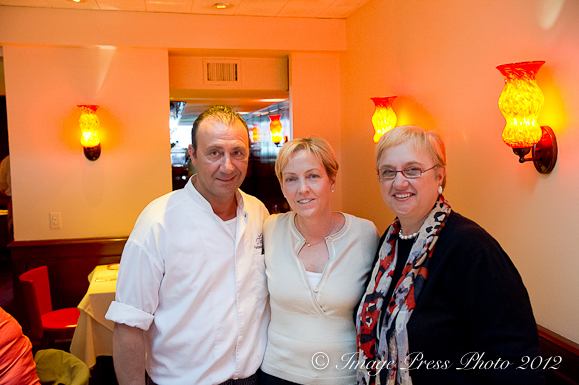
With Chef Fortunato Nicotra and Lidia Bastianich at Felidia
We had lunch at Felidia before meeting Lidia and had the pleasure of being introduced to Executive Chef Fortunato Nicotra who has been at Felidia since 1995. Nicotra earned a Michelin Star at the age of 23 at Villa Marchese Restaurant in Milazzo, Sicily. Since his arrival at Felidia, the restaurant has received numerous accolades including earning three stars from Ruth Reichl of the New York Times just three months after Chef Nicotra arrived. Felidia was named by Wine Spectator as one of the “Top Ten Italian Restaurants in the United States” in 1998. In 2008, USA Today’s Jerry Shriver said Felidia was #2 in his year-end round up of best restaurants in the world.
Our lunch at Felidia was one of our highlights while visiting New York City. The beautiful scallop appetizer I had (no photo) was exceptional. The Nantucket scallops were perfectly seared and incredibly sweet. Chef Nicotra said they cannot always get those scallops, but they are very special when they do. I also had Tonno, Yellow Fin Tuna “Palermitana”. The fish was grilled on just one side, served rare with roasted fennel and an Agrodoci Sauce.
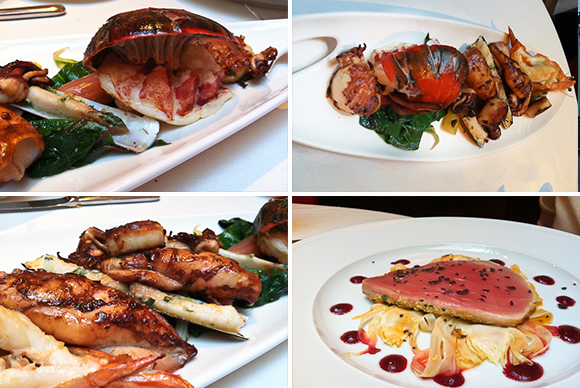
A few of our dishes from lunch at Felidia
Mr. B had a gorgeous seafood dish, Grigliata Di Pesce, with scallops, lobster, calamari, shrimp and razor clams. Everything was presented beautifully and perfectly cooked. The quality of the ingredients was evident in every course. We only took a few photographs with the iPhone so that we would not disturb other diners, but each dish that arrived outdid the one before it.
I have made several of Lidia’s recipes at home and they have been excellent. I would like to share one with you here, Torta di Riso e Zucchine (Rice and Zucchini Crostata). This dish did have a few steps, but the results were outstanding. We ate it as a main course with a salad since it was quite satisfying. It would also be perfect to serve as a first course or appetizer. The following notes about the recipe are from Lidia:
This is a generously proportioned version of the delicious rice-and- zucchini crostata, or tart, that my cousin prepared when our family first visited Genova, nearly fifty years ago. She made hers in a small baking pan, and mine is the same, only bigger! I use a half-sheet baking pan (a jelly-roll pan will work, too) lined with the olive-oil-based dough that has no leavening, is easy to make, and fantastic to roll. The large size of this crostata is necessary, I find, because the crostata disappears right away.
Whether I put it on a buffet in bite-sized party pieces, bring it to a picnic, or serve it as a plated appetizer or main course with salad, everyone loves it—and has to have another piece. And in the unlikely event you do have leftovers, they can be frozen and reheated—just as good as when freshly baked.
The procedure is straightforward and quick, though there’s one important (and interesting) step you must leave time for: steeping the uncooked rice with the shredded zucchini. Since squash is a watery vegetable and rice is dry and starchy, this steeping allows the rice to extract most of the vegetable water from the zucchini. In this way, the grain is softened enough to cook during the baking time, and without absorbing all the liquid from the ricotta and milk. The result is a moist, creamy, and flavorful filling.
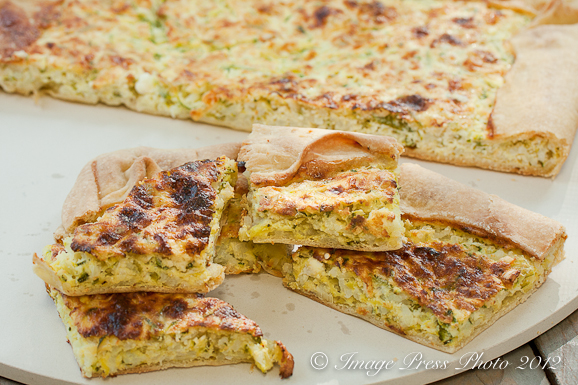
Torta di Riso e Zucchine
Buon Appetito!
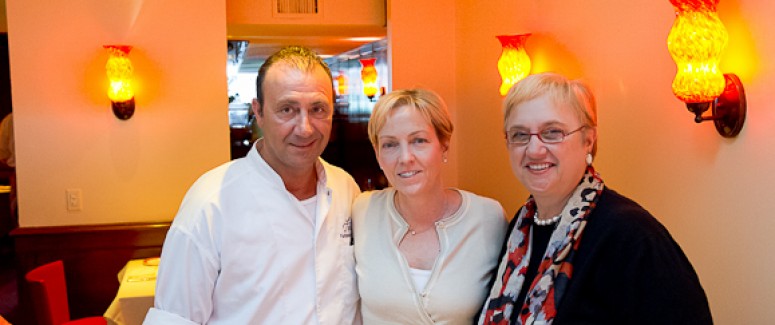
Torta di Riso e Zucchine (Rice and Zucchini Crostata
Ingredients:
For the dough:
2 cups all-purpose flour, plus more for working
1 teaspoon kosher salt
1/2 cup extra-virgin olive oil
1/3 cup cold water, plus more as needed
For the filling:
1 pound small zucchini
1/2 cup Italian short-grain rice, such as Arborio, Carnaroli, or Vialone Nano
2 cups ricotta, preferably fresh, drained overnight
1 cup grated Grana Padano or Parmigiano-Reggiano
2 bunches scallions, finely chopped (about 2 cups)
3 large eggs, lightly beaten
2 cups milk
2 teaspoons kosher salt
Butter for the baking pan
Directions:
You will need a food processor; a baking stone, if you have one; a 12-by- 18- inch rimmed baking sheet (a half-sheet pan).
To make the dough:
1. Put the 2 cups flour and the salt in the food processor fitted with the metal blade. Pulse a few seconds to aerate. Mix the oil and water together in a spouted measuring cup. With the processor running, pour the liquid through the feed tube and process about 30 seconds, until a soft dough forms and gathers on the blade. If it doesn’t, it is probably too dry. Add more water, in small amounts, until you have a smooth, very soft dough.
2. Turn the dough out onto a lightly floured surface and knead by hand for a minute, until it’s smooth and soft. Pat into a rectangle and wrap in plastic wrap. Let rest at room temperature for 1/2 hour. (The dough can be refrigerated for up to a day, or frozen for a month or more. Defrost in the refrigerator, and return to room temperature before rolling.)
To make the filling:
1. Shred the zucchini on the coarse holes of a box grater into a large bowl. Toss the rice and shredded zucchini together, and let sit for 30 minutes to an hour, so the grains absorb the vegetable liquid.
2. Fold in the ricotta (breaking up any lumps), then the grated cheese, scallions, beaten eggs, milk, and salt, stirring until thoroughly mixed. When you’re ready to bake the torta, set a rack in the bottom half of the oven—with a baking stone on it, if you have one—and heat the oven to 375º. Spread the butter on the bottom and sides of the pan.
3. On a lightly floured surface, roll the dough to a rectangle that’s at least 4 inches longer and wider than the baking sheet. Transfer the dough to the pan, either by folding it in quarters and lifting it onto the sheet, or by rolling it up around the floured rolling pin and then unfurling it over the baking sheet. When the dough is centered over the pan, then gently press it flat against the bottom and rim of the pan, leaving even flaps of overhanging dough on all sides. (If the dough tears as you are moving it, patch it with a bit of dough from the edges.)
4. Pour and scrape the rice-zucchini filling into the dough-lined pan, and spread it to fill the crust in an even layer. Fold the dough flaps over the top of the filling, pleating the corners, to form a top crust border that looks like a picture frame, with the filling exposed in the middle. Set the pan in the oven (on the heated stone), and bake until the crust is deep golden brown and the filling is set, 45 minutes to an hour. About halfway through the baking time, turn the pan in the oven, back to front, for even color and cooking. Cool the torta on a wire rack for at least 30 minutes to set the filling before slicing. The torta can be served warm or at room temperature, cut into appetizer or bite-sized pieces in any shape you like— squares, rectangles, triangles, or diamonds.
Lidia Bastianich
Recipe from lidiasitaly.com
Reprinted with express permission
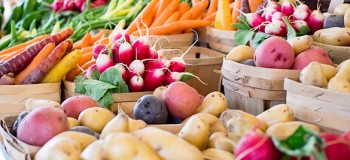















How do Mr. B and you stay so thin dining at such top restaurants? Lidia’s life story is amazing and a testament to how far passion and hard work can get you in life.
Hi Christine,
Yes, Lidia’s story is an amazing one and incredibly inspiring.
Thankfully, we have been staying relatively “thin” throughout the travels and incredible dining experiences. However, I cut way back when we are home and try to exercise to make up for the times we are away.
Hope to see you again soon!
Gwen
This sounds delicious!
What a fantastic article! Ms. Bastianich ate at my friend Nick Pellegrino’s restaurant, “Mangia Nashville” when she did a fundraiser for PBS! He flew his own little Italian Mama down from New York, just to see Ms. Bastianich. Mama Pellegrino was so proud of his son for making that meal for Ms. Bastianich, that she quite literally wept!
Hi Susan,
Thank you for your comment. That is such a great story. I hope Lidia will come back to Nashville one day and that you have the opportunity to meet her. She was such a gracious lady and very inspirational.
Gwen
Great article. I love Lidia. Going to try this recipe!
Hi Suddie,
I always think of you when I post a vegetarian recipe. I know you will enjoy this recipe and if you need to freeze the leftovers, they are great reheated.
Say “hello” to Vance for me! 😉
Gwen
Very cool, Gwen! What an amazing woman! Thank you for sharing this! That recipe looks awesome too. I pretty much love anything with zucchini in it.
Hi Julie,
Yes, she is amazing and is an inspiration to all of us who share a passion for great food and preserving our heritage.
I am sure you will enjoy this recipe!
Gwen
I’ve always loved her shows and recipes but never knew much about her. I sometimes forget to be grateful that I grew up never know the kinds of struggles so many people face as a way of life. Makes her success even sweeter though!
Hi Jen,
I agree. Speaking with someone who has achieved so much and come from so little is the real inspiration. It shows that you really can do anything with your life if you have the desire and the drive. Combined with her passion for real food and family, interviewing Lidia was one of the highlights of our year.
Gwen
I think I’ve been watching Lidia on public television since I was a kid. I’ve made many of her dishes from her cookbooks, and they’re always perfect – always rave reviews – AND..I have had the immense pleasure of dining at Felidia, twice..and one of those times I had the Grigliata Di Pesce! Molto Bene! Gwen, what a fantastic interview, I cannot wait for part two (I can’t believe I’m ‘finally’ waiting on a ‘part’, and it’s not 160B lol)
Hi Lisa,
I am so glad that you have made some of Lidia’s recipes and have dined at Felidia. You can understand how delightful our lunch was and how great her recipes are. I hope that we can meet at Felidia on our next trip to NYC!
Gwen
It has taken me a while to finally sit down and read – savor – this interview and Lidia’s story but what a story! This is absolutely fascinating and what a fabulous chance to be able to interview her like this. And you have offered us a flavorful and complete story. Beautiful and inspiring! And the food! Wow!!!! Fabulous write up, Gwen…and now off to enjoy Part II!
Hi Jamie,
Thank you and yes, it was a great opportunity to sit down with Lidia and learn so much about her. It was one of our favorite interviews and such a pleasure to be able to spend this time with her.
Gwen
Wonderful interview and Lidia is inspirational. I will have to go to Felidia the next time we are there. It sounds like it is delicious. The torta di riso looks fantastic. I’ve never had one like that before. Great details and can’t wait to see the 2nd part.:)
Hi Lora,
Thank you and yes, Lidia’s story is very inspirational. We have been to both Felidia and Becco at different times while in New York and have enjoyed them both. I can highly recommend either. Our lunch at Felidia was definitely one of our culinary highlights during our trip to New York as was Eataly. We should go there together sometime! Can you imagine the trouble we could get into dining and shopping there?!
Gwen
What a fabulous inteview!!! You are so thorough, I especially enjoyed learning about her childhood. I need to watch more of her shows and read more of her books. I always remember her slicing and onion, leaving such a tiny bit of the skin in tact on the bottom. And when asked how she did not go through the bottom skin, she simply said “you will know”. That always stuck with me. Great piece, now I must read part two!
Hi Wendy,
Thank you for your comments. I have really enjoyed delving in to the cookbooks I have by Lidia. The recipes are great and I love the stories and tips that she gives. Several are companion books to her series, so they give you information that you would also learn by watching her television show. I always feel like I have spent my time wisely when I come away from reading or watching something on television that teaches me something new or that I remember and associate with the person. That is great to hear that you have that memory from Lidia’s show.
Gwen
I’ve always enjoyed watching Lidia so it’s most interesting to learn more about her background and business ventures. Now I’m dying to try that crostata…just when I thought I didn’t want any more zucchini…nice work Gwen.
Hi Barbara,
Thank you so much. You will not be sorry you made another zucchini dish when you prepare this recipe. We had some of the crostata for dinner the first night and then put the rest in the freezer and it reheats perfectly. I know you will enjoy it as an appetizer with some of those fabulous Friday cocktails of yours! 😀
Gwen
Pingback: My 2012 Favorite Cookbooks! | the little kitchen
Pingback: My 2012 Favorite Cookbooks! (Closed) | the little kitchen
Pingback: Lidia’s Rice and Zucchini Crostata - A Family Feast
Can u use substitute cooked rice in this recipe ?
Hi Janet,
You need to use raw rice since the grains absorb the liquid from the zucchini. If you use cooked rice, the grains have already absorbed moisture, so the recipe won’t work.
Best,
Gwen